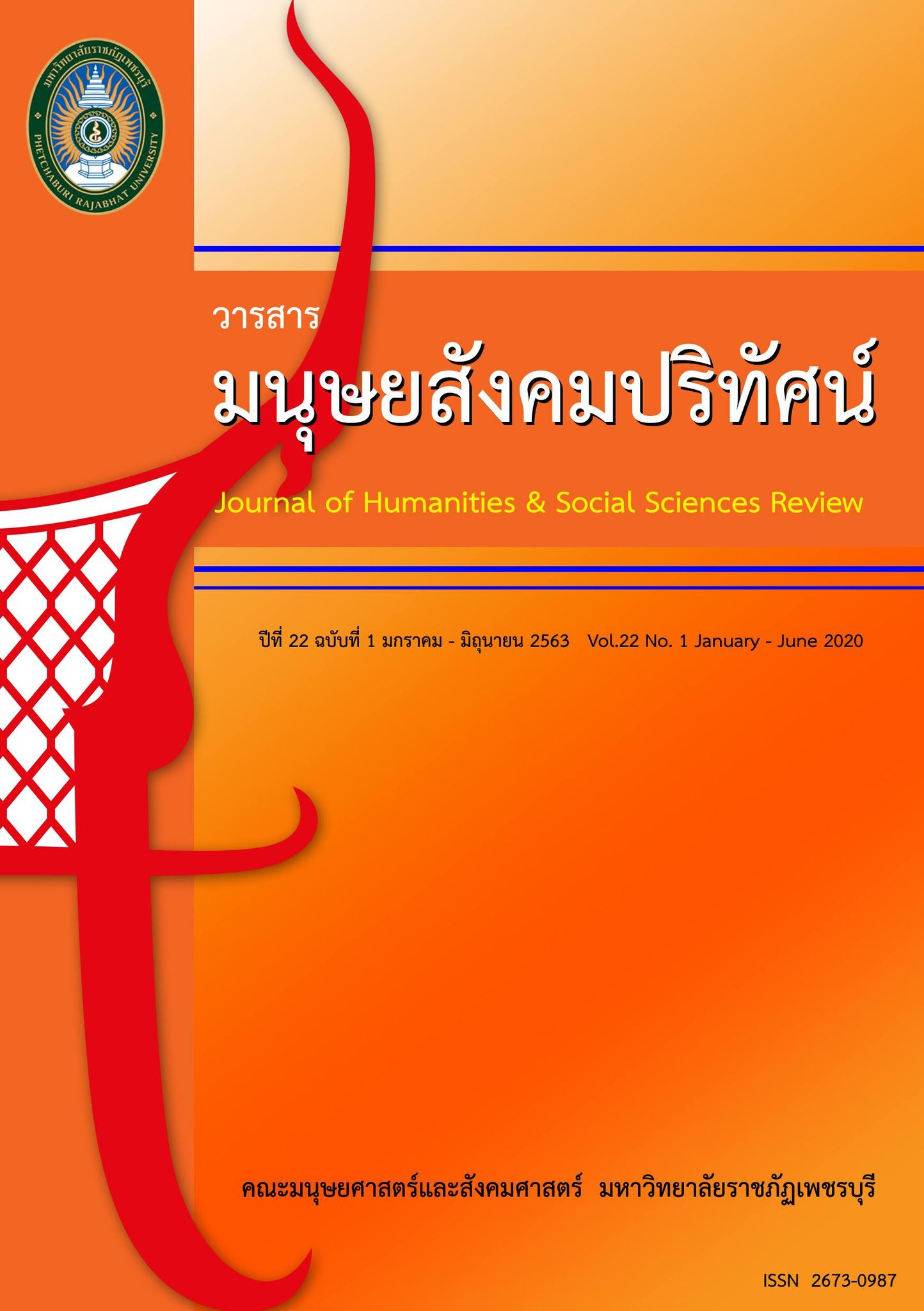Self-guided Study in Cultural Tourist Attraction: A Case Study of Wat Koh Community, Phetchaburi Province
Main Article Content
Abstract
The objectives of this research were to: 1) develop a self-guided tour book of Wat Koh community, 2) study and collect knowledge in Wat Koh community, and 3) evaluate practical use of a self-guided tour book of the Wat Koh community. The research target groups consisted of 1) villagers in Wat Koh community using purposive sampling for collecting data on the structure of a self-guided tour book of the Wat Koh community, 2) 100 tourists who visited Wat Koh community using accidental sampling for evaluating practical use of a self-guided tour book. Data were analyzed by using mean and percentage. The information about the history of Wat Koh and archaeological sites in the Wat Koh community used to create a tour book was compiled by historical method and presented by analytical description.
The research results were as follows: 1) The researcher developed a self-guided tour book of Wat Koh community by defining the content structure from a meeting with villagers in the community. Its title was "Waiphra Waichao Yankao Wat Koh". This book consisted of 3 parts: Part 1 “Waiphra” presented archaeological sites in the area of Wat Koh and other temples around Wat Koh community, Part 2 “Waichao” presented the shrines located in Wat Koh community, Part 3 “Yankao Wat Koh” presented the way of life and tourist attractions in Wat Koh community. 2) To study and collect the knowledge in Wat Koh community, it was found that Wat Koh community had the potential to develop into the cultural tourism attraction. Due to its outstanding arts and cultures and the unique way of life regarded as a strong points that could be used as the tourist attraction, 3) To evaluate practical use of a self-guided tour book of Wat Koh community, it was found that all aspects were satisfied at a high level (mean= 4.11). The aspect that had the highest level was accuracy and comprehensiveness of the content (mean= 4.60)
Article Details
1. Any views and comments in the article are the authors’ views. The editorial board has not to agree with those views and it is not considered as the editorial board’s responsibility. In case, there is any lawsuit about copyright infringement, it is considered as the authors’ sole responsibility.
2. The article copyright belonging to Faculty of Humanities and Social Sciences, Phetchaburi Rajabhat University are copyrighted legally. Republication must be received direct permission from the authors and Phetchaburi Rajabhat University in written form.
References
กัลยาณี กุลชัย. (2560). การสร้างคู่มือการท่องเที่ยวชุมชนโดยกระบวนการมีส่วนร่วมของชุมชนตำบลบางน้ำผึ้ง อำเภอพระประแดง จังหวัดสมุทรปราการ. วารสารสังคมศาสตร์ มหาวิทยาลัยศรีนครินทรวิโรฒ, 20(20): 26-41.
ชายชาญ ปฐมกาญจนา. (2556). แนวทางการส่งเสริมการท่องเที่ยวเชิงวัฒนธรรมแบบมีส่วนร่วมของชุมชนตลาดบางหลวง อำเภอบางเลน จังหวัดนครปฐม. วิทยานิพนธ์มหาบัณฑิต สาขาวิชาพัฒนศึกษา มหาวิทยาลัยศิลปากร.
มธุรส ปราบไพรี และคณะ. (2550). การวิจัยผลกระทบจากการจัดการการท่องเที่ยวในชุมชนวัดเกาะ. เพชรบุรี: คณะมนุษยศาสตร์และสังคมศาสตร์ มหาวิทยาลัยราชภัฏเพชรบุรี.
มลทิชา แจ่มจันทร์ และคณะ. (2550). การจัดระบบข้อมูลด้านการท่องเที่ยวเชิงวัฒนธรรมของชุมชนวัดเกาะ อำเภอเมือง จังหวัดเพชรบุรี. เพชรบุรี: คณะมนุษยศาสตร์และสังคมศาสตร์ มหาวิทยาลัยราชภัฏเพชรบุรี.
มหาวิทยาลัยศิลปากร. (2543). รายงานสรุปภาพรวมการท่องเที่ยวประเทศไทยและกรณีศึกษาโครงการรักษาเอกลักษณ์ของสถาปัตยกรรมท้องถิ่นและสิ่งแวดล้อมเพื่อดึงดูดนักท่องเที่ยว (เชียงราย แพร่ หนองบัวลำพู เลย กระบี่ ตราด นครปฐม เพชรบุรี). กรุงเทพฯ: มปท.
ลัคนา ชูใจ และคณะ. (2550). การศึกษาบริบทแหล่งท่องเที่ยวเชิงวัฒนธรรมของชุมชนวัดเกาะ. เพชรบุรี: คณะมนุษยศาสตร์และสังคมศาสตร์ มหาวิทยาลัยราชภัฏเพชรบุรี.
สุจริต มานิตกุล. (2552). การพัฒนาคู่มือท่องเที่ยวชุมชนตำบลบางขุนไทร อำเภอบ้านแหลม จังหวัดเพชรบุรี. กรุงเทพฯ: มหาวิทยาลัยมหิดล.
Coltman, Michael M. (1989). Travel and Tourism. New York: Van Nostrand Reinhold.
WP. (2562). ล้วง Insight การใช้งาน “ดิจิทัล” ทั่วโลก 2019 “คนไทย” ใช้เน็ต 9 ชั่วโมงต่อวัน-มือถือมี 99 แอป. ค้นเมื่อ มีนาคม 1, 2562, จาก https://www.marketingoops.com/reports/global-and-thailand-digital-trend-2019/.


